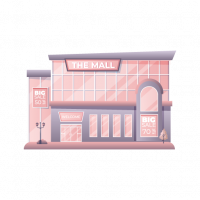Experiential Marketing | Malls Boosts Sales | Digitally | Elyts

In the era of digital shopping, brick-and-mortar stores are facing stiff competition. However, malls can leverage experiential marketing to create immersive, engaging experiences that attract customers and drive sales. By focusing on sensory engagement, personalization, and interactive experiences, retailers can turn casual shoppers into loyal customers.
What is Experiential Marketing?
Experiential marketing is a strategy that directly engages
consumers by creating memorable and interactive brand experiences. Unlike
traditional advertising, which focuses on conveying messages, experiential
marketing allows consumers to connect with brands through hands-on
participation.
The Role of Experiential Marketing in Malls
Malls are more than just shopping destinations; they are
social hubs where people gather for entertainment and leisure. Incorporating
experiential marketing in malls can transform shopping into an engaging
activity that increases foot traffic and sales. Here’s how:
1. Interactive Pop-Up Stores
Pop-up shops featuring interactive elements such as
augmented reality (AR), virtual reality (VR), and live product demonstrations
provide customers with an immersive brand experience. These temporary stores
create urgency, encouraging shoppers to make purchases before the experience is
gone.
2. Live Events and Demonstrations
Hosting live events like fashion shows, cooking
demonstrations, or product testing enhances customer engagement. These events
allow shoppers to experience products firsthand, increasing the likelihood of a
purchase.
3. Personalized Shopping Experiences
Technology-driven solutions such as AI-powered assistants
and smart mirrors personalize the shopping journey. By offering tailored
recommendations, malls can provide a unique and memorable shopping experience
that fosters customer loyalty.
4. Gamification and Rewards
Gamification techniques, such as interactive kiosks,
scavenger hunts, and digital reward systems, encourage shoppers to participate
in-store activities. Providing incentives, such as discounts or exclusive
deals, enhances engagement and drives sales.
5. Multi-Sensory Experiences
Engaging multiple senses can create lasting impressions.
Scent marketing, ambient music, and visually appealing displays stimulate
emotions and influence purchasing decisions. For example, a clothing store
using soft lighting and a pleasant fragrance can create a welcoming ambiance
that encourages shoppers to stay longer and buy more.
Benefits of Experiential Marketing in Malls
- Increased
Foot Traffic: Unique experiences draw more visitors to malls.
- Stronger
Brand Loyalty: Customers who engage with brands in a meaningful way
are more likely to return.
- Higher
Sales Conversion Rates: Interactive experiences help customers make
informed buying decisions.
- Social
Media Amplification: Shoppers share their experiences online,
providing organic promotion for brands.
Conclusion
Experiential marketing is a game-changer for malls looking
to boost sales and enhance customer engagement. By creating memorable and
interactive shopping experiences, retailers can differentiate themselves from
online competitors and build stronger relationships with their audience.
Implementing strategies like pop-up stores, live events, personalization,
gamification, and multi-sensory engagement can transform malls into dynamic and
profitable shopping destinations.
Elyts Advertising and Branding Solutions | www.elyts.in (India) | www.elyts.agency (UAE)






















Leave a Comment